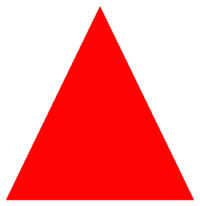A beautiful geometric sequence!
 The Sierpinski Triangle involves a sequence of geometric figures. The first figure in the sequence is an equilateral. The second has an inverted (white) equilateral inscribed inside an equilateral triangle as shown. Each subsequent figure in this sequence is obtained by inserting an inverted (white) triangle inside each non-inverted (shaded) triangle of the previous figure. How many regions ( both white and shaded together) are in the
tenth
figure in this sequence?
The Sierpinski Triangle involves a sequence of geometric figures. The first figure in the sequence is an equilateral. The second has an inverted (white) equilateral inscribed inside an equilateral triangle as shown. Each subsequent figure in this sequence is obtained by inserting an inverted (white) triangle inside each non-inverted (shaded) triangle of the previous figure. How many regions ( both white and shaded together) are in the
tenth
figure in this sequence?
For example, the first three figures in the sequence have 1 region, 4 regions and 13 regions respectively.

The answer is 29524.
This section requires Javascript.
You are seeing this because something didn't load right. We suggest you, (a) try
refreshing the page, (b) enabling javascript if it is disabled on your browser and,
finally, (c)
loading the
non-javascript version of this page
. We're sorry about the hassle.
2 solutions
More about Sierpinski triangle
For n = 1 there are 3 0 − 1 = 1 regions, for n = 2 there are 3 0 − 1 + 3 2 − 1 = 4 regions and so on. So for the 10th figure that is ∑ n = 1 n = 1 0 3 n − 1 = 2 9 5 2 4 regions.
Sorry, can you edit your solution as it is unclear. How is 3^9=29524? 3^9 is 19683 and 'For n = 0 there are 3^(n-1) regions' does not make sense. Thank you
Log in to reply
You are totally right... It has to be summed from n=0 to n=9... Being mobile now editing is hard, I will do it on pc later.
Log in to reply
It was faulty (see comments below). Should be right now.
Sierpinski triangle
The number of regions is given by the recurrence R ( 1 ) = 1 , R ( 2 ) = 4 and R ( n ) = 3 R ( n − 1 ) + 1 for n > 1 . The value of R ( 1 0 ) can then be obtained by solving this recurrence or using the formula R ( n ) = 2 3 n − 1 . The number of regions turns out to be 2 9 5 2 4 .